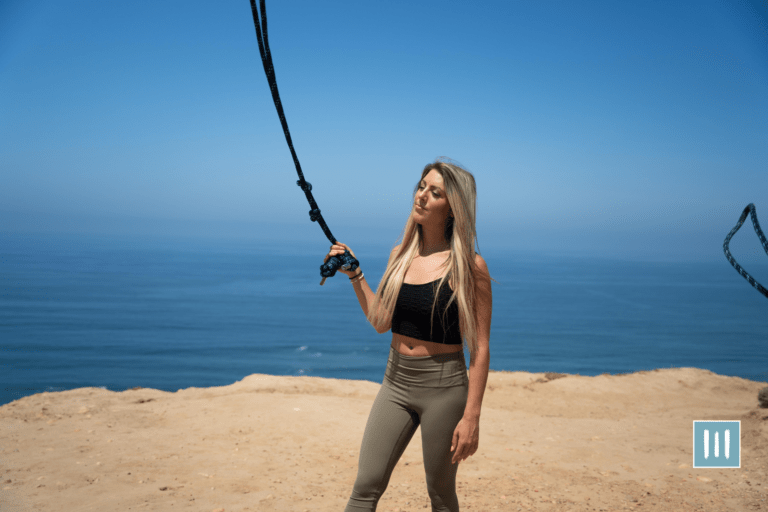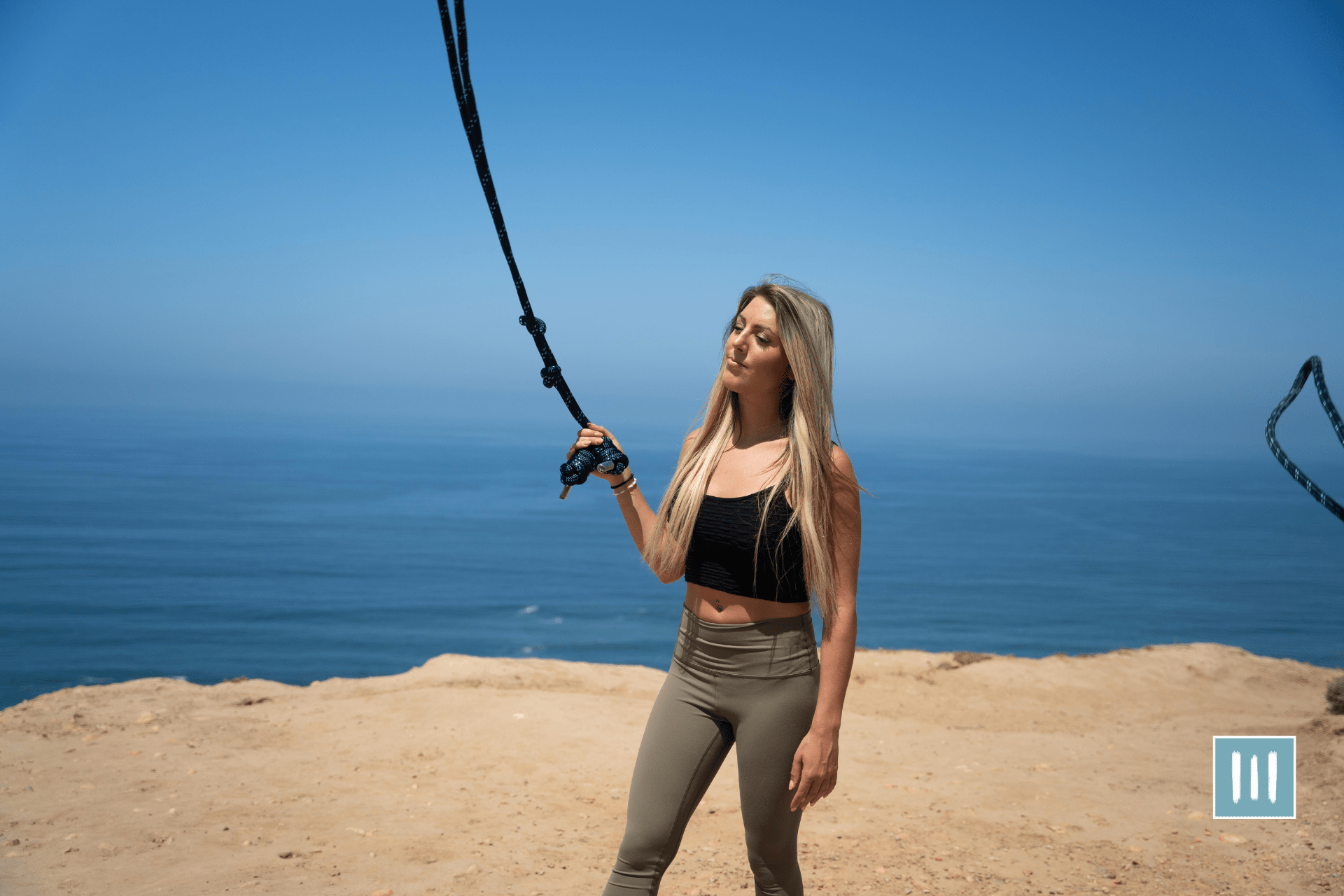Fitness constantly evolves, offering fresh ways to challenge both body and mind. Enter ropex flow training—an energizing exercise regimen merging movement, strength, and endurance. This workout isn’t just about sweat; it’s a graceful symphony demanding coordination, rhythm, and focus.
Visualize the rope moving in waves and loops while your body responds in sync. It’s not just about getting fit; it’s about coordination, rhythm, and focus. From its roots in sports training, rope flow has become a go-to for everyday workouts, offering incredible benefits for your entire body.
This guide unveils 13 simple tips to make your rope flow training enjoyable, effective, and easy to follow. These tips help you reach your fitness goals while having a blast. So, grab your rope, let’s dive in, and start mastering the art of rope flow!
Choosing the Right Rope for Your Training
The appropriate rope for your training is crucial to optimize your rope flow workout experience. Here’s a breakdown of considerations to help you choose the suitable rope:
Material: Ropes come in various materials like nylon, polyester, or polypropylene. Nylon ropes offer durability, while polyester ropes are known for their resistance to stretching. Polypropylene ropes are lightweight and float, ideal for outdoor use near water.
Thickness and Weight: Thicker ropes provide more resistance and a more intense workout. Beginners might prefer thicker ropes for better grip and control, while advanced users might opt for thinner ropes for increased speed and agility.
Length: The length of your rope should accommodate the space you have for training. Generally, longer ropes allow for more movement patterns, while shorter ropes might be suitable for confined spaces or specific exercises.
Handle Design: Handles play a crucial role in grip and comfort. Look for handles that fit your hand comfortably, with sufficient padding to reduce strain during extended workouts.
Quality and Durability: Invest in a high-quality rope designed for durability, especially if you plan on regular or intense use. Check for reinforced handles and quality construction to ensure longevity.
Consider these factors when choosing your rope to align with your fitness goals, skill level, and training environment. Trying out different ropes can also help you find the one that best suits your preferences and enhances your rope flow training experience.
Warming Up and Stretching Before Rope Flow
Before you start, warm up and stretch your muscles to prepare for rope flow. Warming up is essential to prevent injury and maximize your performance during the training session.
You can start with light cardio exercises like jumping jacks or jogging to increase your heart rate and warm up your entire body. This will help increase blood flow to your muscles and loosen them up.
After your warm-up, stretching your muscles to improve flexibility and prevent muscle strain is essential. Focus on stretching the muscles in your arms, shoulders, back, and legs, as these are the main muscle groups used in rope flow.
To target these areas, you can perform simple stretches like arm circles, shoulder rolls, and forward bends.
Always listen to your body, and never push yourself too hard during stretching. Extending to mild tension is important but not to the point of pain.
Hold each stretch for about 15 to 30 seconds and repeat the stretches on both sides of your body.
Warming up and stretching before rope flow will help prevent injury and improve your overall performance. By preparing your body correctly, you are setting yourself up for success and allowing yourself to engage in the training session fully.
So, please take a few minutes to warm up and stretch before you start, and watch how it enhances your rope flow skills.
Mastering Basic Jump Rope Techniques
Discover the secrets to perfecting your jump rope skills and become a master of the basic techniques. Jump rope is not just a simple exercise but an art form that requires precision, coordination, and practice.
By mastering the basic jump rope techniques, you can perform impressive tricks and routines that will leave others in awe.
Here are three essential tips to help you on your journey to becoming a jump rope master:
- Start With The Basics: Before attempting any advanced tricks, it’s vital to master the basic jump rope techniques. Begin by learning the basic jump, also known as the “two-foot jump.” This involves jumping with both feet together and clearing the rope smoothly. Once you’ve mastered this technique, you can move on to more advanced jumps, such as the single-leg and alternating foot jumps.
- Focus On Rhythm and Timing: Jump rope is about finding your rhythm and timing. To achieve a smooth and effortless flow, it’s crucial to sync your jumps with the rotation of the rope. Pay attention to the sound of the rope hitting the ground and use it as a cue to time your jumps. Practice counting the beats or finding a catchy song to jump to. You can easily perform tricks and combinations by developing a sense of rhythm and timing.
- Keep Practicing and Challenging Yourself: Like any skill, jump rope requires consistent practice to improve. Set aside dedicated time each day to work on your jump rope skills. Start with a few minutes and gradually increase the duration as you progress. Challenge yourself by learning new tricks and combinations. Push yourself out of your comfort zone and strive for continuous improvement. With perseverance and dedication, you’ll soon master jump rope techniques.
Incorporating Advanced Tricks and Combos
Mastering complex techniques and combining them seamlessly adds an exciting level of challenge and creativity to your rope flow practice. Once you have a solid foundation of basic jump rope skills, you can begin to incorporate advanced tricks and combos that will elevate your performance to new heights. These tricks and combos require precision, timing, and coordination, but with practice, you can become a master of the ropes.
One way to incorporate advanced tricks into your routine is to start with one trick and gradually build upon it. For example, you can begin by mastering the double under, where the rope passes under your feet twice in one jump. Once you have perfected this technique, you can add in more complex tricks, such as cross-overs, where you cross your arms in front of your body while jumping.
By combining these tricks, you can create a seamless flow of movements that will impress anyone who watches.
Another way to incorporate advanced tricks is to experiment with different combinations. Try combining tricks that complement each other and flow naturally from one to the next. For example, you can start with a double under, transition into a cross-over, and finish with a crisscross. The key is to practice these combinations until they become second nature, allowing you to perform them effortlessly.
As you become more comfortable with these combos, you can add flair, making them unique to your style.
Incorporating advanced tricks and combos into your rope flow training adds excitement and creativity and challenges you to push your boundaries and strive for mastery. So, don’t be afraid to step out of your comfort zone and try new tricks. You can wow audiences with your impressive rope flow skills with dedication and practice.
Keep pushing yourself; soon enough, you’ll be a rope flow master.
Developing Speed and Stamina
Developing speed and stamina in rope flow training requires a gradual and strategic approach to enhance cardiovascular endurance and agility. Here are key tips to boost your speed and stamina:
- Interval Training: Incorporate high-intensity interval training (HIIT) into your rope flow routine. Alternate between bursts of high-speed rope movements and periods of active recovery. This method can enhance both speed and stamina by pushing your cardiovascular limits.
- Consistency: Consistent practice is vital for improving speed and stamina. Start with shorter sessions and gradually increase the duration as your endurance builds. Regular practice will help condition your body for longer and more intense workouts.
- Focus on Technique: Prioritize proper technique over speed initially. Master fundamental rope flow movements such as waves, slams, or figure eights with precision. As your technique improves, gradually increase the speed while maintaining form to prevent injury and maximize efficiency.
- Incremental Progression: Gradually increase the intensity and speed of your rope flow sessions. Push your limits progressively, allowing your body to adapt and build endurance.
- Cross-Training: Incorporate other cardio exercises like running, cycling, or swimming to complement your rope flow training. This variety helps improve overall cardiovascular fitness, contributing to enhanced stamina.
- Rest and Recovery: Adequate rest and recovery are essential for improvement. Ensure you allow your body enough time to recover between intense sessions to prevent overtraining and reduce the risk of injury.
Integrating these strategies into your rope flow routine can progressively enhance your speed and stamina, achieving better overall fitness and performance. A little tip: patience and consistent effort are vital to improving your endurance and speed over time.
Adding Resistance and Weight to Your Rope
Incorporating resistance and additional weight to your rope can amplify the effectiveness of your rope flow training, challenging your muscles and enhancing overall strength. Here are ways to add resistance and weight:
- Heavier Ropes: Opt for thicker and heavier ropes to increase resistance. Thicker ropes require more effort to move, intensifying your workout and engaging muscles more intensely. Experiment with different rope diameters to find the resistance level that challenges you without compromising your form.
- Weighted Handles: Attach weighted handles or grips to your rope. These accessories add extra pounds to the handles, increasing the load on your arms and upper body during rope movements. Start with lighter weights and gradually progress to heavier ones as your strength improves.
- Ankle/Waist Weights: Wear ankle or waist weights while performing rope flow exercises. This added weight increases the difficulty of movements, particularly engaging your core and lower body muscles.
- Resistance Bands: Combine resistance bands with your rope flow routine. Loop the bands around the rope or attach them to fixed points for added resistance during exercises like waves or slams.
- Sandbags or Attachments: Integrate sandbags or attachments that can be affixed to the rope. These add-ons create drag and resistance, making your movements more challenging and engaging various muscle groups.
- Gradual Progression: Start with lighter resistance and gradually increase weight or resistance levels over time. This progressive overload helps your muscles adapt and grow stronger.
When incorporating additional resistance or weight into your rope flow training, it’s essential to maintain proper form and technique to prevent injury. Gradually introduce these modifications, allowing your body to adjust to the increased workload and listen to your body’s cues to avoid overexertion.
Cross-training with Other Fitness Activities
To take your cross-training to the next level, here are three tips to keep in mind:
- Mix Up The Intensity: Varying the intensity of your workouts can help you avoid plateaus and keep your body guessing. Try incorporating both high-intensity and low-intensity exercises into your routine. For instance, you could start with a high-intensity jump rope session, followed by a weightlifting circuit with lower weights and higher repetitions. This combination will challenge your muscles in different ways and help you achieve better results.
- Focus On Form: When engaging in cross-training activities, it’s important to prioritize proper form and technique. This ensures that you are performing the exercises correctly and helps prevent injuries. Take the time to learn the correct form for each exercise, and maintain good posture and alignment throughout your workouts.
- Listen To Your Body: Pay attention to how your body feels during and after each workout. If you experience any pain or discomfort, it’s essential to rest and allow your body to recover. Pushing through pain can lead to injuries and setbacks in your training. Remember, rest and recovery are just as important as the actual workouts, so give your body the time it needs to heal and rebuild.
Keep these tips in mind, and enjoy the journey towards mastering your rope flow skills!
Creating a Structured Training Plan
Developing a structured training plan for rope flow ensures progressive improvement, prevents plateauing, and helps you stay focused on your fitness goals. Here’s a guide to creating a structured rope flow training plan:
- Assess Your Current Fitness Level: Evaluate your fitness level and identify your goals—improving endurance, building strength, or enhancing overall fitness.
- Set Clear and Realistic Goals: Establish specific, achievable, and time-bound goals. For instance, aim to increase your rope flow session duration, master particular movements, or improve overall stamina within a defined timeframe.
- Plan Your Training Schedule: Determine the frequency and duration of your rope flow workouts. Aim for consistency, scheduling sessions that align with your lifestyle and allow sufficient recovery time between workouts.
- Warm-up and Cool-down Routines: Incorporate warm-up exercises to prepare your body for the workout and prevent injuries. Similarly, include cooldown exercises to gradually lower your heart rate and stretch your muscles, aiding recovery.
- Varied Workouts: Design a diverse routine with various rope flow movements, intervals, and intensity levels. Integrate exercises targeting different muscle groups to ensure a well-rounded workout.
- Progressive Overload: Gradually increase your workouts’ intensity, duration, or complexity to challenge your body and stimulate continual improvement.
- Rest and Recovery: Allow adequate rest days between intense sessions to prevent burnout and facilitate muscle recovery. Recovery is crucial for muscle repair and overall performance enhancement.
- Track Your Progress: Keep a workout journal or use apps to track your progress. Record workout durations attempted variations, and any endurance or strength improvements.
- Adapt and Modify: Regularly reassess your plan. Adjust exercises, intensity, or duration based on your progress, goals, and feedback from your body.
- Seek Professional Guidance: Consult a fitness trainer or coach specializing in rope flow for personalized guidance and feedback.
Following a structured training plan tailored to your goals and abilities, optimize your rope flow workouts, progress steadily, and maintain motivation along your fitness journey.
Tracking Your Progress and Setting Goals
Tracking progress and setting goals is essential to a successful rope flow training regimen. Here’s a straightforward approach to track progress and set achievable goals:
- Establish Clear Goals: Define specific and measurable objectives for your rope flow training. Whether increasing session duration, mastering new techniques, or improving endurance, having clear goals provides direction and motivation.
- Use Metrics to Measure Progress: Track quantitative metrics such as workout duration, number of repetitions, or increased resistance levels. This helps in assessing improvements and staying accountable.
- Keep a Workout Journal: Maintain a dedicated journal or use fitness apps to log your workouts. Record details like exercises performed, sets, reps, and any notes about your performance or how you felt during the workout.
- Regular Assessments: Periodically evaluate your progress against your set goals. This assessment can occur weekly, bi-weekly, or monthly to determine if you’re on track or need to adjust your training plan.
- Celebrate Milestones: Acknowledge and celebrate achievements along the way. Meeting smaller milestones can boost morale and motivation to progress toward larger goals.
- Adjust Goals as Needed: Be flexible with your goals. If you achieve a goal sooner than expected, set new challenges or adjust existing goals to maintain momentum and progress.
- Set Realistic Timeframes: Ensure your goals are achievable within a reasonable timeframe. Unrealistic goals may lead to frustration, while achievable goals boost confidence and motivation.
- Focus on Performance: Instead of solely concentrating on outcomes like weight loss or muscle gain, emphasize improvements in technique, endurance, or mastering new rope flow movements. Improving performance often leads to desired outcomes.
- Visual Progress Tracking: Consider taking photos or videos periodically to document your progress visually. This can be a motivating visual reminder of how far you’ve come.
- Stay Consistent: Consistency is key. Stick to your training routine and tracking methods to maintain progress and achieve your goals over time.
You’ll maintain motivation, stay accountable, and witness tangible improvements in your rope flow training by consistently tracking your progress and setting realistic yet challenging goals.
Proper Form and Technique for Injury Prevention
To prevent injuries, maintain proper form and technique while training with the rope. Good form is essential for maximizing your performance and reducing the risk of injury. When using the rope, keeping your body aligned and engaging the right muscles is essential. Here are some tips to help you maintain proper form and technique:
- Stand with your feet hip-width apart and your knees slightly bent. This will provide a stable base and help you maintain balance while jumping.
- Keep your core engaged and your back straight. Avoid hunching over or arching your back, as this can strain your spine unnecessarily.
- Hold the handles of the rope lightly, with your wrists relaxed. Avoid gripping the handles too tightly, as this can cause tension in your forearm muscles.
- Jump with a soft landing using the balls of your feet. Avoid landing with a flat foot or on your heels, as this can put more stress on your joints.
- Start with shorter jumping sessions and gradually increase the duration and intensity of your workouts. This will allow your body to adapt to the demands of rope flow training and reduce the risk of overuse injuries.
| Proper Form and Technique | Benefits | Common Mistakes |
|---|---|---|
| Feet hip-width apart | Provides stability and balance during jumping | Feet too close together or too far apart, leading to loss of balance |
| Landing with a flat foot or on the heels can increase joint stress | Reduces strain on the spine and improves posture | Hunching over or arching the back, which can lead to back pain |
| Light grip on handles | Prevents tension in the forearm muscles | Landing with a flat foot or on the heels, can increase joint stress |
| Soft landing using the balls of the feet | Reduces impact on the joints and prevents injury | Gripping the handles too tightly causes unnecessary muscle tension |
| Gradually increasing workout intensity | Allows the body to adapt and reduces the risk of overuse injuries | Starting with high-intensity workouts without building up endurance |
Rest and Recovery for Optimal Performance
Rest and recovery are essential for peak performance, as studies have shown that athletes who prioritize adequate rest experience a 20% decrease in injury rates compared to those who neglect recovery.
Regarding rope flow training, it’s easy to get caught up in the excitement and push yourself to the limit daily. However, it’s important to remember that rest is just as crucial as training sessions. Your body needs time to repair and rebuild; you risk overtraining and burnout without proper rest.
During rest periods, your muscles and connective tissues can repair any damage that may have occurred during your training sessions. This repair process is essential for strengthening and building endurance, allowing you to perform at your best.
Furthermore, rest and recovery also play a key role in preventing injuries. Giving your body time to recover reduces the risk of overuse injuries and fatigue-related accidents.
So, schedule regular rest days into your training routine and listen to your body’s cues for when it needs a break. Remember, rest is not a sign of weakness but a smart strategy for optimizing your performance and achieving mastery in rope flow training.
Nutrition and Hydration for Rope Flow Training
Ensuring proper nutrition and hydration is essential for achieving peak performance in rope flow. To optimize your training and fuel your body for success, follow these key tips:
- Stay well-hydrated: Hydration through Minimal vacuum insulated sports bottle is crucial for maintaining energy levels and preventing fatigue during intense rope flow sessions. Drink plenty of water throughout the day, and hydrate before, during, and after your training. Aim to consume at least 8-10 glasses of water daily to keep your body functioning at its best.
- Fuel up with balanced meals: To support your rope flow training, focus on consuming a balanced diet that includes a mix of lean proteins, whole grains, fruits, and vegetables. Protein is essential for muscle repair and growth, so include sources such as chicken, fish, tofu, or beans in your meals. Complex carbohydrates like quinoa, brown rice, or whole wheat bread will also provide sustained energy for your workouts.
- Snack smart: In between meals, choose healthy snacks that will boost energy without weighing you down. Opt for nutrient-dense options like nuts, Greek yogurt, or fresh fruit to keep hunger at bay and maintain steady energy levels. Avoid sugary snacks or processed foods, as they can lead to energy crashes and hinder your performance.
You’ll set yourself up for success in your rope flow training by prioritizing proper nutrition and hydration. Remember, mastery comes from not only perfecting your technique but also taking care of your body from the inside out.
Staying Motivated and Consistent in Your Practice
Staying motivated and consistent in your practice can be challenging, but with a few simple strategies, you can stay on track and achieve your goals. One important tip is to set specific and attainable goals for yourself. By setting clear objectives, you can give yourself something to strive for and measure your progress against. For example, you might aim to increase your rope flow training sessions from three to five times a week within the next month. This specific goal gives you a clear target to work towards and helps keep you motivated.
| Emotion Evoking Strategy | Example |
|---|---|
| Visualization | Imagine yourself effortlessly flowing through a complex rope flow sequence, feeling the exhilaration of each movement. |
| Positive Affirmations | Repeat affirmations such as “I am dedicated and committed to my rope flow practice” to reinforce your motivation and belief in yourself. |
| Reward System | Treat yourself to a small reward after reaching a milestone, such as completing a challenging routine or achieving a new personal best. |
Frequently Asked Questions
How can I prevent injuries while practicing rope flow training?
To prevent injuries while practicing rope flow training, start by warming up your body and stretching to increase flexibility. Focus on proper technique and form, and listen to your body for any signs of discomfort. Take breaks when needed and gradually increase the intensity of your training.
What are some practical warm-up exercises specifically for rope flow training?
Start with dynamic stretches like arm circles and leg swings to warm up effectively for rope flow training. Then, incorporate some low-intensity rope movements to get your muscles ready. Remember, a good warm-up is vital to preventing injuries and maximizing performance.
Can I use any rope for rope flow training, or are there specific ones I should use?
You’ll be glad to know you can use any rope for rope flow training! However, there is an interesting statistic: using a weighted rope can increase calorie burn by up to 40%!
Are there any specific cross-training activities that can enhance my rope flow training?
Try incorporating activities like jump rope intervals, agility ladder drills, and bodyweight exercises to enhance your rope flow training. These cross-training exercises will improve your coordination, endurance, and overall athleticism, helping you master the art of rope flow.
How can I track my progress and set goals for my rope flow training?
To track your progress and set goals for rope flow training, start by recording your initial performance metrics. Then, establish specific, measurable speed, endurance, and complexity targets. Regularly review and adjust your goals to stay motivated and achieve mastery.

















